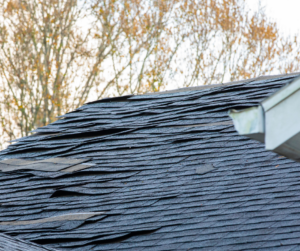Homeowner, do you know what condition your roof is in? Chances are, you don’t, especially if you had the roof installed just a few years ago. (“It’s still new! I’m sure it has no damage!”)
Don’t worry, you’re not alone. Most homeowners assume that a newer roof has no problems and will last for two or three decades. And, generally, it will, unless damage occurs.
Roof damage changes a roof’s longevity numbers. A damaged roof can still last a long time if the problem area gets fixed quickly, but a damaged roof can fail quickly if repairs are ignored.
Regardless of the age of your roof, keep alert to the following warning signs.
Do You See Dark Spots?
Dark-colored shingles have become more popular recently. Homeowners like the way dark shingles provide contrast with light exterior wall colors. The fact that dark shingles hold in heat, reducing energy costs in the winter, also makes them appealing in colder areas of the country.
Still, dark shingles can make it harder to see water damage. Roof leaks can sometimes be identified by the wet spots they create on shingles, but when shingles are dark, the wet spots may blend in.
If you see dark spots, don’t ignore them. Get a roofer, deal with the leak, and fix the roof.
Missing Shingles
Homeowners can usually spot missing shingles, but not always. Say the area with the missing shingles lies in an obscured corner, or at the top of the roof, or on a back plane that you can’t see because trees block the view.
Gaps in shingle coverage can lead to water damage. Yes, there is a layer of protective material under the shingles, but this can get damaged too. If you don’t see or if you ignore the missing shingles for a long time, you’re inviting problems.
Shingles That Curl

Shingles curl or warp in response to several conditions.
- Improper installation. Shingles not sealed properly, or shingles installed on top of worn-out shingles, can warp or curl.
- Very cold weather. Shingles can curl in response to temperatures dropping dramatically.
- Attics with no ventilation. Summer heat building up in attics can cause the shingles above to “bake” and curl.
Areas of the Roof That Dip and Give
Say you stand on a ladder to clean gutters, glance across the planes of your roof, and see a low area. You then get onto the roof, walk across the low area, and notice it feels a little spongy under your feet.
This often indicates that the decking below the shingles has moisture damage and is deteriorating. Left unaddressed, that deterioration will become rot.
Call a roofer to look at the area and make the necessary repairs.
About Supplementing a Damaged Roof
Are you a roofing contractor? Do you submit supplements for roofing jobs regularly? If so, you understand the importance of spotting the signs of roof damage early.
You also know that a roof with damage often means multiple roofing supplements that need processing. Call American Roof Supplements and get our expert help. We’ve written thousands of supplements and have helped hundreds of roofing contractors get paid.
